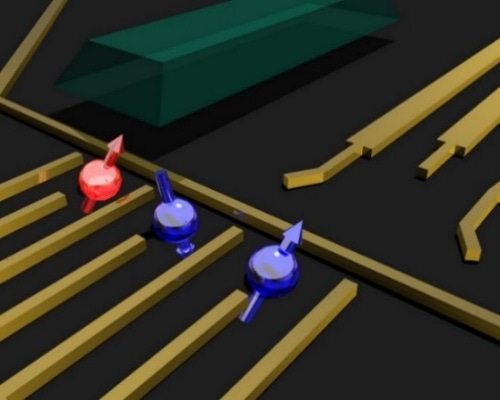Dec 31 2018
Although it has been observed that spin-based quantum computers exhibit the capabilities to deal with challenging mathematical problems that cannot be solved by ordinary computers, there have been challenges in rendering these machines scalable.
 Schematic of the device. (Image credit: RIKEN Center for Emergent Matter Science)
Schematic of the device. (Image credit: RIKEN Center for Emergent Matter Science)
Currently, an international team of scientists headed by the RIKEN Center for Emergent Matter Science has developed an innovative architecture for quantum computing. The researchers used two different types of qubit—the basic computing element of quantum computers—to build a hybrid device that can be used to develop a device that can be quickly initialized and read out, and that maintains high control fidelity at the same time.
With traditional computers reaching their limits, quantum computers—which perform calculations based on quantum phenomena—have been considered as potential alternatives, and they have the ability to deal with problems in a highly distinct and potentially far more rapid manner. Yet, scaling them up to the size needed for carrying out real-world calculations has been proven to be very challenging.
In 1998, Daniel Loss, one of the authors of this study, in collaboration with David DiVincenzo of IBM, suggested a proposal to develop a quantum computer by making use of the spins of electrons embedded in a quantum dot—a small particle with behavior similar to that of an atom, but which can be manipulated, and hence at times known as “artificial atoms.” From that time, Loss and his colleagues have made several attempts to develop practical devices.
Constructing practical devices poses a number of barriers with respect to speed. Firstly, it is necessary for the device to be able to quickly initialized. Initialization is the process in which a qubit is placed in a specific state. If it is not possible to carry out this process rapidly, the device it slowed down. Secondly, it is necessary for the qubit to maintain coherence for a time sufficiently long to carry out a measurement. Here, coherence means the entanglement between two quantum states, and eventually, this is used to carry out the measurement; therefore, if environmental noise renders the qubits decoherent, for instance, the device turns out to be worthless. Lastly, it is essential that the ultimate state of the qubit is read out quickly.
Although researchers have proposed various methods for constructing a quantum computer, the one put forward by Loss and DiVincenzo stays one of the most practically feasible since it is based on semiconductors, for which a large industry already exists.
For this study, reported in Nature Communications, the researchers combined two types of qubits on a single device. The first type, a kind of single-spin qubit known as a Loss-DiVincenzo qubit, has very high control fidelity—that is, it is in a clear state, rendering it perfect for calculations—and has a long decoherence time, so that it remains in a given state for a comparatively long time before it loses its signal to the environment.
Sadly, the disadvantage of these qubits is that it is impossible to quickly initialize them into a state or read out. Although the second type, known as a singlet-triplet qubit, can be quickly initialized and read out, it becomes decoherent rapidly. For the research, the researchers integrated the two types of qubits with a kind of quantum gate called a controlled phase gate, which enabled spin states to be entangled between the qubits within a time period sufficiently fast to maintain the coherence, thus facilitating the state of the single-spin qubit to be read out by the fast singlet-triplet qubit measurement.
With this study we have demonstrated that different types of quantum dots can be combined on a single device to overcome their respective limitations. This offers important insights that can contribute to the scalability of quantum computers.
Akito Noiri, Study Lead Author, RIKEN Center for Emergent Matter Science